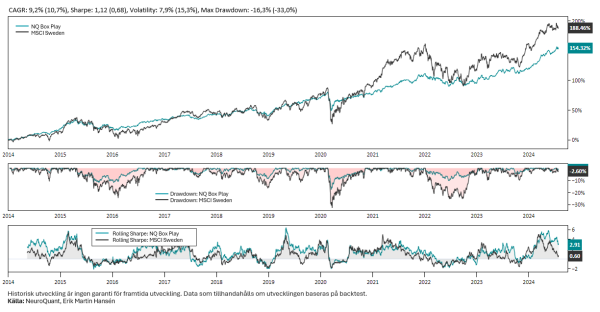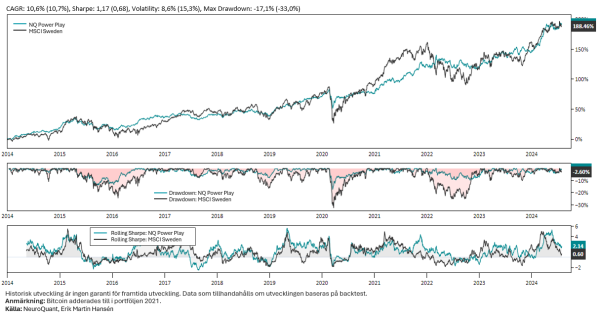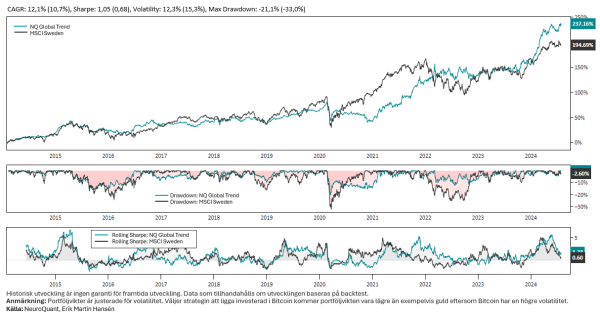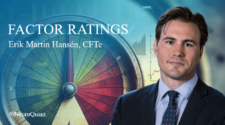Prioritize survival instead of maximum return

Prioritize survival instead of maximum return! With global asset allocation, we build capital over time without having to go through the emotional roller coaster of the stock market.
The path to the goal is crucial to being able to be long-term and achieve success. With the help of a diversified “base portfolio”, we build a stable foundation that ensures that we can do well, regardless of how our stock or trading portfolios develop.
“You should have a strategic asset allocation mix that assumes that you don’t know what the future is going to hold“. – Ray Dalio
Global asset allocation
We offer strategic and tactical asset allocation with different levels of risk. These portfolios are intended as inspiration for how to diversify, reduce volatility while generating good returns.
Owning 100% of the shares works well in theory, but is often less effective for most people in practice. Which is the best solution for you? Of course, it depends on your needs and life situation.
Our strategies
- NQ Box Play (Strategic Buy and Hold)
- NQ Power Play (Strategic Buy and Hold)
- NQ Global Trend (Tactical allocation with trend following)
- NQ Tactical Diversification (Dynamic Allocation with AI)
Box Play and Power Play are new strategies that replace the previous “all-weather portfolio”.
NQ Box Play
NQ Box Play is a strategic “buy and hold” portfolio with exposure to all macro environments. The strategy invests in stocks, bonds, commodities and gold. Regardless of what happens with growth and inflation, we sleep well at night and build capital over time with less volatility than the stock market. The goal is to deliver the highest possible return given a fixed asset allocation.
Statistics:
- CAGR: 9,2% (10,7%)
- Sharpe: 1,12% (0,68)
- Volatility: 7.9 (15.3%)
- Max decline: 16.3% (-33%)
Figures in parentheses refer to the stock market.
Login required to view holdings.
Not a customer? Open an account to access our analytics service.
NQ Power Play
NQ Power Play is a “buy and hold” portfolio with a more aggressive nature than NQ Box Play. In addition to stocks, bonds, commodities and gold, the portfolio has exposure to Bitcoin and soft commodities, which is financed by a lower allocation to bonds. The goal is to generate as high a return as possible given a fixed asset allocation. The portfolio has slightly higher volatility than NQ Box Play, but clearly lower risk than 100% stocks.
Statistics:
- CAGR: 10,6% (10,7%)
- Sharpe: 1,17% (0,68)
- Volatility: 8.6 (15.3%)
- Max decline: 17.1% (-33%)
Figures in parentheses refer to the stock market.
Login required to view holdings.
Not a customer? Open an account to access our analytics service.
NQ Global Trend
NQ Global Trend is a tactical asset allocation strategy that combines time-series momentum and cross-sectional momentum. The strategy invests in the top 3 global markets and adjusts portfolio weights according to their volatility. The goal is to beat the stock market over time while avoiding major market declines. Please note that portfolio performance may deviate significantly from the stock market performance during periods.
Statistics:
- CAGR: 12,1% (10,7%)
- Sharpe: 1,05% (0,68)
- Volatility: 12.3%(15.3%)
- Max decline: 21.1% (-33%)
Figures in parentheses refer to the stock market.
Login required to view holdings.
Not a customer? Open an account to access our analytics service.
NQ Tactical Diversification
NQ Global AI is a tactical asset allocation strategy that uses AI to optimize risk-adjusted returns. The AI model uses economic data, volatility, breadth, positioning and price data to find patterns and optimal allocation across asset classes. The goal is to achieve a higher risk-adjusted performance than the stock market over time.
Statistics:
- CAGR: 9,9% (5,8%)
- Sharpe: 1,38% (0,33)
- Volatility: 7.2%(17.7%)
- Max decline: -6.4% (-33.0%)
Figures in parentheses refer to the stock market.
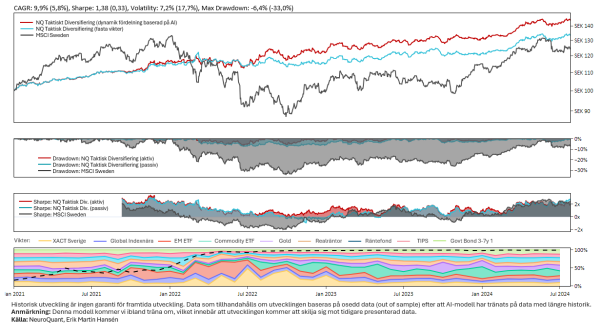 Holdings NQ Tactical Diversification:
Holdings NQ Tactical Diversification:
Login required to view holdings.
Not a customer? Open an account to access our analytics service.
More information
Find your investment process
It is important to develop your own investment process based on your goals and risk preferences. Risk preferences can vary depending on age and individual risk tolerance. In general, a longer time horizon can allow for higher risk-taking. On the right we see an example of how different portfolios and strategies can be used to both protect capital and improve returns.
Investing 100% in stocks has historically yielded good returns over long periods of time. On average, the stock market has yielded an annual return of 8%. However, this comes at the risk of losing half of the capital. Over the course of a long-term investor’s investment lifetime, the stock market has on several occasions lost around 50% of its value, sometimes even more. Many people believe that diversification is the only “free lunch” in the market. With a stable basic portfolio, we don’t have to fear the stock market’s sharp fluctuations.
Lower volatility helps us be long-term
The path to the goal is of great importance for whether we will be able to be long-term and successful. The stock market is very volatile, and it is easy to sell off your shares during major declines or take too much risk at the end of a cycle. We may have planned to be long-term, but the market's large fluctuations can lead to bad decisions based on strong emotions. The best strategy is the one we can maintain over time. Strategic and tactical asset allocation helps us be long-term, build capital and increase purchasing power over time.
Our studies show that proper diversification between stocks, fixed income, commodities and gold reduces portfolio volatility while achieving returns almost as high as the stock market.
Frequently asked questions
Where can I find the holdings and portfolio weights?
The model portfolios are included in the premium package. You can find the holdings and weights in this article.
How do I invest in the portfolios?
Our model portfolios on global asset allocation should be considered as strategies to get inspiration and ideas for constructing a “base portfolio” where we build capital over the long term and sleep well at night. Investing requires your own decisions about which instruments to trade and which strategy is suitable.
What is the difference between strategic and tactical asset allocation?
The difference between strategic and tactical asset allocation lies in the time frame and flexibility in how assets are allocated within an investment portfolio. The goal of strategic asset allocation (SAA) is to create an optimal mix of assets that can achieve long-term investment goals. Tactical asset allocation (TAA) is more short-term and takes into account current market conditions where we try to take advantage of market trends and opportunistic opportunities.
You previously had an “all-weather portfolio.” What is it?
We have two portfolios that are considered “all-weather portfolios”, namely NQ Box Play and NQ Power Play. An “all-weather portfolio” is a passive and strategic asset allocation that has exposure to all macro environments. NQ Box Play and NQ Power Play are both passive buy and hold strategies where Box Play is more defensive than Power Play.
The difference between NQ Power Play and NQ Global Trend?
NQ Power Play is a passive buy and hold strategy, i.e. strategic asset allocation, while NQ Global trend is tactical asset allocation. It can be psychologically difficult to have a high allocation in an active strategy during periods of underperformance. Many people therefore like to combine strategic and tactical asset allocation.
Does historical development refer to real development?
The performance we present on global asset allocation is based on backtesting. We are not a fund company where we, for example, present performance for funds to invest in. We have not optimized the strategies to present strong historical performance. We perform strategies that are robust with reasonable returns.
What instrument do you use for Bitcoin?
We use Valour Bitcoin (BTC) Zero SEK with ISIN CH0585378661.
Which portfolio should I choose as a “base portfolio” in my savings?
You need to consider how much volatility you are willing to accept. If you want the portfolio to fall by 20% at most, you should choose a defensive portfolio with low volatility. One alternative is to combine strategic asset allocation with tactical asset allocation. For example, place 50% in a passive “buy and hold” portfolio and place 50% in an active strategy based on trend.
What is the difference between NQ Global Trend and NQ Tactical Diversification?
These are two completely different strategies with different approaches. NQ Global Trend based on a trend-following strategy and NQ Tactical Diversification on neural networks. Trend-following strategies work well when the different asset classes are trending and an AI model works well when it finds patterns that repeat. A trend-following strategy makes money even if history does not repeat itself, but develops weakly when there is a lack of sustainable trends. Equities have given the best returns.
Why not invest 100% in stocks?
This is true when we study long periods of time and compare with, for example, interest rates or commodities. Over time, stocks have yielded about 8% per year, but there is a risk of losing 50% of the capital. Sometimes the stock market has fallen even more. The stock market has also had 10-year periods where the market has not yielded any return at all. If you entered the stock market at the wrong time, it has taken a very long time to get your money back. We believe that it is a good idea to diversify!
Can I replace XACT Sweden with Avanza Zero?
Yes, you can replace all holdings with ETFs or funds that have similar exposure. The important thing is the concept of diversification where we create exposure to other asset classes. Our holdings in the All Weather Portfolio are fixed, but we have previously changed holdings for various reasons and may do so again in the future. Commodity ETFs sometimes deviate from commodity indices. Why? This may be due to contango and backwardation in the futures market. Increased costs when futures contracts are rolled will affect the performance of an ETF. One is that commodity indices are often spot prices and not something that can be invested in.
What do you think about using momentum to weight holdings?
We like trend and momentum, especially if we take advantage of diversification benefits. We use this concept in the NQ Global Trend strategy. The strategy is based on a combination of time-series momentum and cross-sectional momentum, which means we look at the market and also compare how the market is developing in relation to other markets.
Bitcoin is said to have a positive impact on a diversified portfolio. Is that true?
Since Bitcoin has risen a lot over the past 10 years, it will have a positive impact on portfolio returns when backtested. When we do a backtest, we have the benefit of hindsight. It is easy to create something that looks very good in retrospect, but that does not help us in the future. That said, it is positive that Bitcoin has a low correlation to many other markets. For the NQ Power Play strategy, Bitcoin is added in 2021 so that the portfolio has experienced a larger decline in Bitcoin, but also an upturn.
Can an “all-weather portfolio” outperform the stock market?
In the short term, anything can happen. In the long term, 100% stocks have a better chance of developing better than the All-Weather Portfolio. Remember that it is the journey to the goal that is important. If we take volatility into account, the All-Weather Portfolio has a better risk-adjusted return. With the All-Weather Portfolio, we optimize for survival instead of return. We want to give ourselves the best chance to be long-term. It will be a less emotional roller coaster than 100% in stocks.
How can an “all-weather portfolio” be a hedge against inflation?
For example, a diversified global portfolio may have exposure to commodities and inflation-protected bonds.
Do you have to rebalance every month?
Strategic portfolios do not need to be rebalanced every month. The important thing is to keep the portfolio balanced.
Warren Buffett is against diversification. What do you think?
Warren Buffett has an infinite time horizon and doesn't see volatility as a risk. What worked for him hasn't worked for most others. Studies show that most investors underperform indexes. One reason is that large swings in the stock market lead to bad decisions. One question you can ask yourself is, do you need the money in the next 5 or 10 years? How would you handle it if the stock market fell by 50%? The best strategy is the one we can stick to over time.
